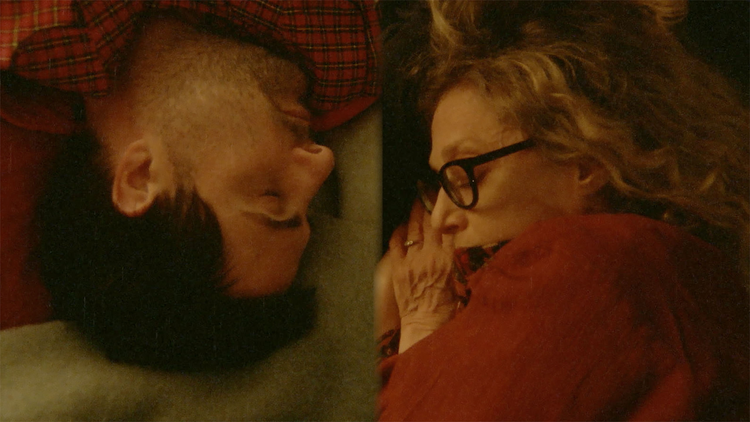Editing the Sundance comedy “Between the Temples” with Adobe Creative Cloud and Frame.io

Sundance Film Festival’s “Between the Temples” is a delightful comedy that explores the themes of faith crisis and human connection. The narrative follows a cantor grappling with a crisis of faith, taking an unexpected turn when his grade school music teacher becomes his adult bat mitzvah student. Crafted by indie stalwart Nathan Silver and co-writer C. Mason Wells, this rare, offbeat comedy unfolds with a perfect blend of humor, heartfelt performances, and emotional depth.
A seasoned Adobe user, editor John Magary heavily relied on Premiere Pro, leveraging Speech to Text and Essential Sound features, along with Frame.io, to bring to life a narrative driven by misadventures and an affectionate celebration of human connection.
Read on below for a glimpse into the making of this film.
How and where did you first learn to edit?
After college, I got a job through a newspaper classified ad to work as a video editor at the Cathedral of Hope in Dallas, Texas. I learned to edit on a piece of software called Media 100, presumably now extinct. My job was mainly doing additional editing on church services, and at night I would stick around in the church’s “TV studio” to edit my own feature film, which was recorded across maybe 50 mini DV tapes. That’s really how I learned — editing that feature, which exists in its final “mastered” form on a handful of VHS tapes scattered across the country.
How do you begin a project/set up your workspace?
I use a pretty standard editing workspace, making sure to maintain easy access to the clip mixer and effects controls. When all the footage is properly subclipped and married to audio, I color label every individual take then make a stringout of a given scene, then I take a preliminary, very generous selects sequence. For more complex, improvised scenes, I use a “take sequence” comprised of “beats” within the scene including each take of that beat. So it’s each line reading of Beat 1, then each line reading of Beat 2, etc., all in one sequence. Then I will drag that sequence into the source window and assemble from that. I work in order, scene by scene, and rarely jump around the project and almost never refer back to the script.
Tell us about a favorite scene or moment from this project and why it stands out to you.
There is a very long dinner sequence in the film which I’m particularly proud of. On set, the scene was entirely improvised, so each new take was very different from the one that preceded it. The editing of just this sequence took a number of weeks. It was a matter of not just finding rhythms and tones, but of finding the scene itself — punching a big mound of black clay until it started to take shape.
What were some specific post-production challenges you faced that were unique to your project? How did you go about solving them?
I worked without an assistant. The footage was prepped for me, but after that, the project was all on me so I had to keep my organization consistent. My methods for doing this are rather simple and, I would imagine, not atypical, but I could not slip by taking too many shortcuts. Every scene needed to be organized in the exact same way with, if possible, a text transcription of every stringout made, so that I could find different readings and words and even parts of words as quickly as possible once feedback started rolling in.
What Adobe tools did you use on this project and why did you originally choose them?
I used Premiere Pro's Essential Sound and Speech to Text tools fairly regularly. Essential Sound is just a simpler way to get a quick filter onto certain audio clips — adding the reverb of a big hall or small room, for example. The Speech to Text tools can be very useful for finding alternate line readings or even alternate cadences to words or parts of words.
Do you use Frame.io as part of your workflow? If so, how do you use it?
If memory serves, we used Frame.io to watch dailies. But not beyond that.
If you could share one tip about Premiere Pro, what would it be?
I would advise new editors to embrace working from sequences rather than from individual clips. Working from sequences in the source monitor is a pretty seamless process in Premiere Pro. Take the time to create string outs and rounds of selects — you will benefit down the road. Also, keep your timeline orderly, uncluttered, and colorful. Color-labeling clips can be very useful.
Who is your creative inspiration and why?
The directors I love are carefree in the strongest sense, and they know how to work the audience. They're performers. David Lynch and Lucrecia Martel and Scorsese, of course, but also Arnaud Desplechin, Claude Chabrol, Spike Lee — directors who constantly surprise. I love feeling surprised, and I love being lost.
What’s the toughest thing you’ve had to face in your career and how did you overcome it? What advice do you have for aspiring filmmakers or content creators?
I’ve had a lot of creative blocks. I’m still working to overcome them and one way I try to do this is by building skills — not just as an editor but as a hobbyist. I build picture frames, I restore old camera lenses, I take lots of photos. All aspiring filmmakers should embrace technicalities, in my opinion, if for no other reason than to demystify such a complicated process.
Share a photo of where you work. What’s your favorite thing about your workspace and why?
It’s too much of a mess right now. I can’t work in a mess, but I’m great at making them.